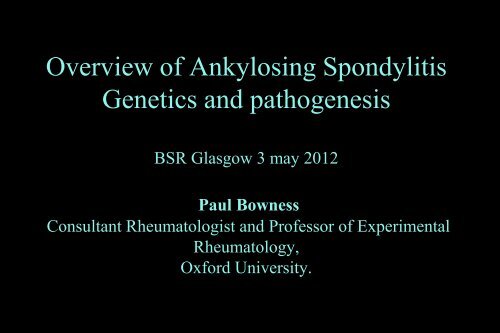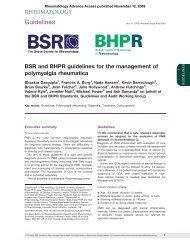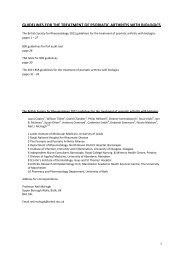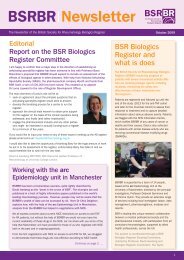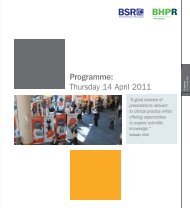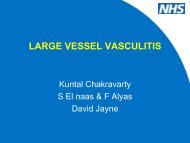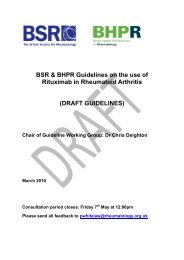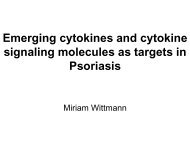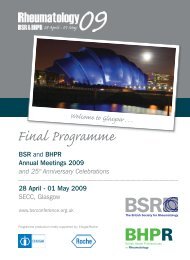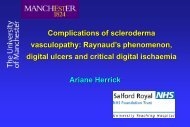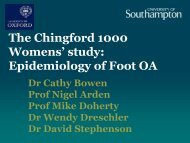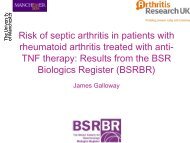Overview of ankylosing spondylitis genetics and pathogenesis
Overview of ankylosing spondylitis genetics and pathogenesis
Overview of ankylosing spondylitis genetics and pathogenesis
You also want an ePaper? Increase the reach of your titles
YUMPU automatically turns print PDFs into web optimized ePapers that Google loves.
<strong>Overview</strong> <strong>of</strong> Ankylosing Spondylitis<br />
Genetics <strong>and</strong> <strong>pathogenesis</strong><br />
BSR Glasgow 3 may 2012<br />
Paul Bowness<br />
Consultant Rheumatologist <strong>and</strong> Pr<strong>of</strong>essor <strong>of</strong> Experimental<br />
Rheumatology,<br />
Oxford University.
• No conflict <strong>of</strong> interest
<strong>Overview</strong><br />
1) Introduction<br />
2) AS <strong>genetics</strong><br />
3) AS theories <strong>of</strong> <strong>pathogenesis</strong><br />
4) Immunotherapy <strong>of</strong> AS, clues to<br />
<strong>pathogenesis</strong>?
AS is<br />
• A common inflammatory rheumatic<br />
disease characterized by sacroileitis<br />
<strong>and</strong> spinal inflammation (<strong>and</strong> HLA-<br />
B27)
Bamboo spine in Ankylosing Spondylitis
Sacroiliitis <strong>and</strong> hip involvement in a patient with AS
MRI showing sacroileitis
Extra-skeletal features <strong>of</strong> AS<br />
• Iritis<br />
• Gut inflammation<br />
• Cardiac<br />
• Lung
HLA B27-associated spondyloarthritides<br />
The spondyloarthritides comprise a group <strong>of</strong> diseases sharing key<br />
clinical features <strong>and</strong> an HLA -B27 association.<br />
• Disease HLA B27 frequency % (approximate)<br />
• Ankylosing <strong>spondylitis</strong> 96%<br />
• Undifferentiated spondyloarthropathy 70%<br />
• Reactive arthritis 30-70%<br />
• Colitis-associated spondyloarthritis 33-75%<br />
• Psoriatic spondyloarthritis 40-50%<br />
• Juvenile enthesitis-related arthritis 70%
• Underst<strong>and</strong>ing <strong>pathogenesis</strong> will improve<br />
targeted treatment.<br />
• Lessons from Genetics <strong>and</strong> from trials <strong>of</strong><br />
Biologic therapies are informative
<strong>Overview</strong><br />
2) AS <strong>genetics</strong><br />
3) AS theories <strong>of</strong> <strong>pathogenesis</strong><br />
4) Immunotherapy <strong>of</strong> AS, clues to<br />
<strong>pathogenesis</strong>?
Genetics <strong>of</strong> AS 1.<br />
• Strong HLA-B27 association<br />
94% vs 9.4% controls Odds<br />
ratio 171 (95% C.I. 135-218)<br />
Brown et al 1996<br />
The prevalence <strong>of</strong> AS around the world parallels the<br />
prevalence <strong>of</strong> HLA-B27<br />
But B27 alone is not enough………
What causes Ankylosing<br />
Spondylitis?<br />
• AS major hereditary component >90%.<br />
• HLA-B27 contributes about 1/3 <strong>of</strong> this.<br />
• The recurrence risks in different degrees <strong>of</strong> relatives<br />
were: monozygotic (MZ) twins 63% (17/27), first degree<br />
relatives 8.2% (441/5390), second degree relatives 1.0%<br />
(8/834). Brown 2000
Genome-wide association study <strong>of</strong><br />
<strong>ankylosing</strong> <strong>spondylitis</strong> identifies non-<br />
MHC susceptibility loci.<br />
• a genome-wide association study in 2,053 unrelated <strong>ankylosing</strong><br />
<strong>spondylitis</strong> cases among people <strong>of</strong> European descent <strong>and</strong> 5,140<br />
ethnically matched controls, with replication in an independent<br />
cohort <strong>of</strong> 898 <strong>ankylosing</strong> <strong>spondylitis</strong> cases <strong>and</strong> 1,518 controls. In<br />
addition to strong association with the major histocompatibility<br />
complex (MHC; P < 10(-800))…..<br />
• We also replicated previously reported associations at IL23R (P =<br />
9.1 x 10(-14)) <strong>and</strong> ERAP1 (P = 5.3 x 10(-12)).<br />
• This study identifies a major role for the interleukin (IL)-23 <strong>and</strong><br />
IL-1 cytokine pathways in disease susceptibility.<br />
Australo-Anglo-American Spondyloarthritis<br />
Consortium (TASC), Reveille JD, … Brown MA.<br />
Nat Genet. 2010 Feb;42(2):123-7.
The Times Monday July 11 2011
Latest GWAS. Interaction between ERAP1 <strong>and</strong> HLA-B27<br />
in <strong>ankylosing</strong> <strong>spondylitis</strong> implicates peptide h<strong>and</strong>ling in<br />
the mechanism for HLA-B27 in disease susceptibility.<br />
• ERAP in B27+<br />
• IL23R, IL-12B (p40) <strong>and</strong> other genes<br />
involved in Th17 responses (eg STAT3)<br />
The Australo-Anglo-American Spondyloarthritis Consortium (TASC); the<br />
Wellcome Trust Case Control Consortium 2 (WTCCC2),<br />
Nat Genet. 2011 Jul 10;43(8):761-767.
What does <strong>genetics</strong> tell us about the immuno<strong>pathogenesis</strong><br />
<strong>of</strong> AS?<br />
√ AS is highly hereditary<br />
√ HLA-B27 critical (<strong>and</strong> not a linked gene)<br />
√ ERAP which is involved in antigen processing.<br />
√ Th17 T cells (+ Tumour Necrosis Factor)
What is the role <strong>of</strong> HLA-B27?
<strong>Overview</strong><br />
3) AS theories <strong>of</strong> <strong>pathogenesis</strong><br />
4) Immunotherapy <strong>of</strong> AS, clues to<br />
<strong>pathogenesis</strong>?
Theories <strong>of</strong> B27 disease causation<br />
1. Arthritogenic peptide<br />
2. Intracellular stress following B27 misfolding<br />
(Colbert, Powis, Antoniou, Goodall, Gaston)<br />
3. Innate immune recognition <strong>of</strong><br />
aberrant B27
Ankylosing <strong>spondylitis</strong> (AS) − Theories <strong>of</strong> immune Pathogenesis<br />
1. Arthritogenic peptide<br />
2. Unfolded protein response<br />
3. HLA-B27 homodimers interact with<br />
KIRs <strong>and</strong> LILRs on immune cells<br />
Nat Rev Rheumatol 2010 6:399
Different Immune receptors can recognize B27<br />
1) Classical immune/autoimmune<br />
CD8 T cell<br />
T cell<br />
receptor<br />
HLA-B27+ peptide
Molecular structure <strong>of</strong> HLA B27<br />
a1<br />
a1<br />
a2<br />
a3<br />
b2m
Model <strong>of</strong> B27 2 homodimer
Different receptors can recognize B27:<br />
2) NK <strong>and</strong> LILR recognition<br />
NK cell/ CD4 T cell<br />
CD8 T<br />
cell<br />
NK family<br />
receptor<br />
Monocytes/ B cells<br />
Dendritic cells<br />
LILR<br />
receptor<br />
HLA-B27+ peptide<br />
B27 2
% expressing KIR3DL2<br />
KIR3DL2+ CD4 T cells are exp<strong>and</strong>ed in SpA<br />
25<br />
#, ##, ### p
IL17 PE<br />
IL17 PE<br />
SpA synovial fluid KIR3DL2+CD4 T cells are<br />
enriched for IL17 production<br />
Blood<br />
Synovial Fluid<br />
1000<br />
0 2.65<br />
1000<br />
0 18.6<br />
100<br />
IL-17<br />
10<br />
0<br />
0<br />
97.3<br />
0 10 1001000<br />
CD3 PerCP<br />
100<br />
10<br />
0<br />
0<br />
KIR3DL2+CD4 T<br />
81.4<br />
0 10 1001000<br />
CD3 PerCP<br />
Anna Ridley, Simon Kollnberger
KIR3DL2+CD4 T cells are<br />
enriched for IL17<br />
production
?related to HLA-B27
Increased T cell IL-17<br />
production in the presence <strong>of</strong><br />
cells expressing HLA-B27 2
% <strong>of</strong> Max<br />
Abnormal HLA-B27 forms can be detected <strong>and</strong> their<br />
functional effects inhibited by a monoclonal antibody HD6<br />
HD6<br />
PBM<br />
HD6<br />
SFM<br />
HD6<br />
PBM<br />
HD6<br />
SFM<br />
HD6<br />
PBM<br />
HD6<br />
SFM<br />
100<br />
80<br />
60<br />
40<br />
20<br />
100<br />
80<br />
60<br />
40<br />
20<br />
HD6 stains AS synovial fluid<br />
<strong>and</strong> peripheral blood CD14+<br />
monocytes<br />
0<br />
0<br />
0 10 1 10 2 10 3<br />
0 10 1 10 2 10 3<br />
SpA 1 SpA 2<br />
RA Patient<br />
IL17 secretion by AS but not healthy<br />
control PBMC stimulated with SEB is<br />
inhibited by HD6. Mean valuesSEM (n=6 AS,<br />
n=3 HC). * P
Possible role <strong>of</strong> ERAP1 (endoplasmic<br />
reticulum aminopeptidase 1) in AS?<br />
• Trimming <strong>of</strong> “arthritogenic” peptides<br />
• Effect on B27 folding in ER<br />
• Effect on stability <strong>of</strong> B27 on cell surface
ERAP K527R has altered function in trimming B27-<br />
presented peptide epitopes<br />
Liye Chen <strong>and</strong> R Fisher in Kochan et al PNAS 2011 108(19): 7745–7750.
<strong>Overview</strong><br />
4) Immunotherapy <strong>of</strong> AS, clues<br />
to <strong>pathogenesis</strong>?
Anti TNF blockade is great in SpA,<br />
but…<br />
• Not everyone responds<br />
• ? Debate about effect on new<br />
bone formation, this may be<br />
“uncoupled” from<br />
inflammation
Anti TNF blockade is great in SpA,<br />
but…<br />
• Not everyone responds<br />
• ? Debate about effect on new<br />
bone formation, this may be<br />
“uncoupled” from<br />
inflammation
The future -<br />
• Match phenotype with genotype<br />
• Better underst<strong>and</strong>ing <strong>of</strong> gene function in disease<br />
• Better earlier diagnosis (D van de Heide)<br />
• New treatments (D Baeten)<br />
• Small molecule inhibitors….<br />
• New treatments to target new bone formation…….
<strong>Overview</strong><br />
1) Introduction<br />
2) AS <strong>genetics</strong><br />
3) AS theories <strong>of</strong> <strong>pathogenesis</strong><br />
4) Immunotherapy <strong>of</strong> AS, clues to<br />
<strong>pathogenesis</strong>?
Acknowledgements<br />
MRC HIU<br />
Simon Kollnberger, Kirsty McHugh, Anna<br />
Ridley, Jackie Shaw, Isabel Wong-Baeza,<br />
Liye Chen, Joanna Giles, Antoni Chan<br />
CCMP<br />
Roman Fischer<br />
Benedikt Kessler<br />
Funders<br />
Action Medical Research<br />
Oxford NIHR Biomedical Research Centre


